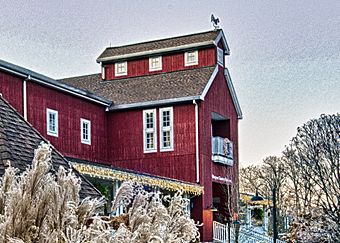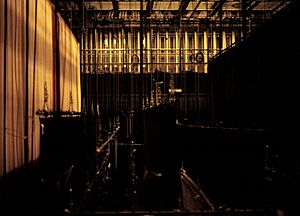Westport Country Playhouse facts for kids

Westport Country Playhouse
|
|
| Address | 25 Powers Court Westport USA |
|---|---|
| Coordinates | 41°08′30″N 73°21′17″W / 41.1416°N 73.3548°W |
| Type | Regional theatre |
| Capacity | 578 |
| Construction | |
| Opened | 29 June 1931 |
| Architect | Edwin Howard |
The Westport Country Playhouse is a special theater in Westport, Connecticut. It's a "not-for-profit" theater, which means it uses its money to put on great shows and teach people about theater, rather than making a profit for owners.
This famous theater was started in 1931 by Lawrence Langner. He was a theater producer from New York. Mr. Langner took an old building from the 1830s and turned it into a modern stage.
Contents
The Playhouse Story: A Look Back
How the Playhouse Building Began
The building where the Westport Country Playhouse stands today was first built in 1835. It was a tannery, a place where animal hides were turned into leather. A family named R&H Haight owned it. Later, in 1866, Charles H. Kemper took over the business.
By the 1920s, the tannery was no longer used. In 1930, Lawrence Langner bought the old building. He hired Cleon Throckmorton, a famous Broadway designer, to help change the inside. They wanted to make it a perfect place for plays.
Opening Night and Early Success
The Westport Country Playhouse opened its doors on June 29, 1931. The very first play was a big event! Soon, the Playhouse became a popular stop on the "straw hat circuit." This was a group of summer theaters in New England.
Famous Years: The 1900s
In the 1940s, the Playhouse started a program for young people who wanted to work in theater. Many famous people were once apprentices here! These include composer Stephen Sondheim and actress Tammy Grimes. The Playhouse still has educational programs today.
The theater closed for a few years during World War II, from 1942 to 1945. After the war, it had many successes. Two plays that started here, Come Back, Little Sheba and The Trip to Bountiful, later became big hits on Broadway.
After the Langner family, James B. McKenzie led the Playhouse for many years. Then, famous actress Joanne Woodward became the artistic director from 2000 to 2005. She helped with a huge renovation project. The Playhouse became a non-profit organization in 1973.
The Playhouse Today
Today, Mark Shanahan is the artistic director of the Westport Country Playhouse. The Playhouse is known for being well-managed. It has received top ratings for its financial health and honesty.
Inside the Playhouse: A Modern Theater
Making the Playhouse New Again
From 2003 to 2005, the Westport Country Playhouse went through a big renovation. This project cost $30.6 million! It was called the "Campaign for a New Era." Many people and organizations donated money to help.
Joanne Woodward and Alison Harris led this huge effort. They turned the old barn into a modern theater that could be used all year. The renovated theater reopened in 2005. Ms. Woodward even had a piece of the original stage floor placed at the dressing room entrance. This was to give actors good luck!
Seating for Everyone
The Westport Country Playhouse has 578 seats. Before the renovation, the seats were wooden benches. Now, they are individual, cushioned seats. They still look historic, but they are much more comfortable! Also, fewer seats have a "limited view" of the stage.
Here's how the seats are arranged:
- 424 Orchestra Seats (on the main floor)
- 234 center orchestra
- 93 house left orchestra
- 97 house right orchestra
- 154 Mezzanine Seats (on the balcony)
- 118 center mezzanine
- 18 left mezzanine boxes
- 18 right mezzanine boxes
Some seats can be changed to make them wheelchair accessible. This helps everyone enjoy the shows.
The Stage Area
The stage is where all the magic happens! It is about 3 feet 2 inches above the audience floor. The stage is about 28 feet deep from the very front to the back wall. There is also plenty of space on the sides of the stage for actors and scenery.
The Proscenium is the arch that frames the stage. It is about 15 feet tall and 32 feet wide. Below the stage, there is an Orchestra pit where musicians can play.
Learning at the Playhouse
Many young people have learned about theater through the Playhouse's programs. Some have become very famous! These include Stephen Sondheim, Frank Perry, and Sally Jessy Raphael. Many others have gone on to have careers in theater.
The Joanne Woodward Internship Program
This special program is named after Joanne Woodward. It offers summer and school-year internships for students aged 19 and older. These students come from all over the country.
Interns get a lot of responsibility and are treated like staff members. They learn a lot by working on different tasks. This includes helping backstage, ushering, and working in concessions. It's a great way to get real-world experience in theater!
Famous Faces on Stage
Many well-known performers have acted at the Westport Country Playhouse over the years. Some of these famous names include Liza Minnelli, Eartha Kitt, Gene Wilder, Paul Newman, James Earl Jones, and Jane Fonda. Imagine seeing them perform live!
Behind the Scenes: Technical Magic
How Scenery Moves: The Fly System
Before the big renovation, the Playhouse used an old-fashioned "hemp house" system. Stagehands would use ropes and sandbags to move scenery up and down.
Now, the Playhouse has a modern counterweight fly system. This system uses weights to balance scenery, making it easier to move. There are 22 "battens" (long pipes) that can hold scenery. They can move scenery from about 4 feet off the stage floor to almost 38 feet high!
Lighting the Stage
The lighting for the shows is controlled from a special booth at the back of the theater. This is where the lighting designer makes sure everything looks just right.
The Playhouse has many different types of lights. These include spotlights and lights that create a wash of color. They also have special attachments like "color scrollers" to change light colors. All these tools help create the perfect mood for each play.




